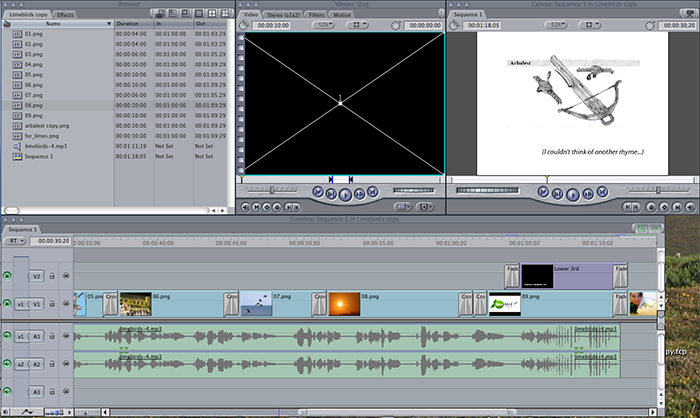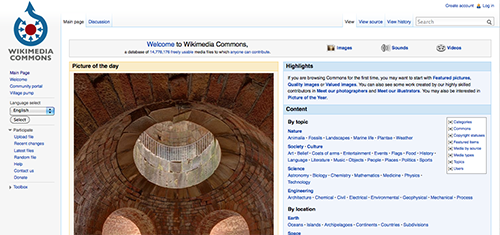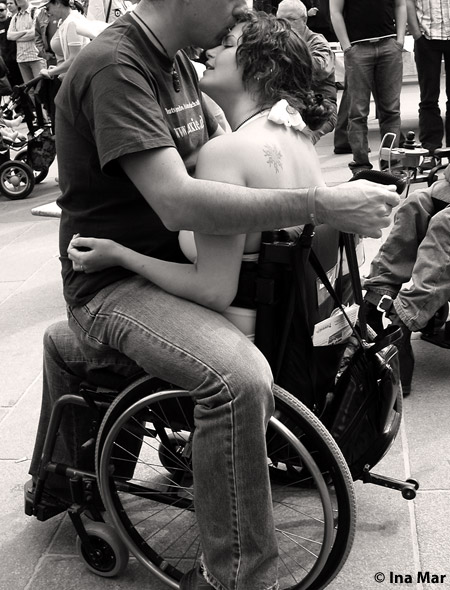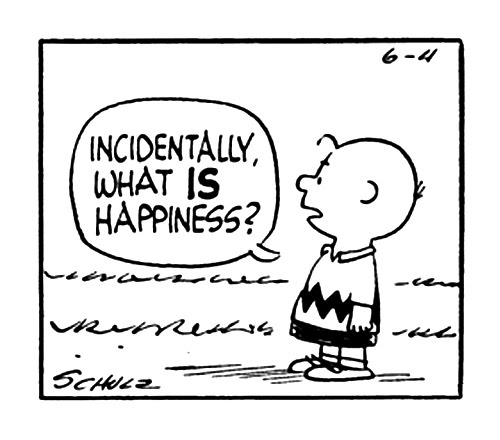by Mayumi-H | Nov 10, 2012 | From Hell (A Love Story), Process
A few weeks ago, the fine folks over at Limebird Writers celebrated their first anniversary. To commemorate, they had a contest with a bunch of fantabulous prizes that would make any aspiring writer’s quill quiver with eager excitement, mine included. My video didn’t win, but the process was such fun – and so easy – I thought I’d share a few of my production steps.
1. Text.
Every story starts with text. (Well, every story starts with an idea, but you need to put the idea on paper if you want to be able to share it.) I wrote a (very loose and very silly) poem, which you can read below:
“Happy birthday, Limebirds!”
Just one short year ago today
The Web was graced with an idea so bright
A place for writers to tell their stories
To craft and let their words take flight
Safe harbor from the fright’ning storm
Of jealous trolls and arbalests
Where artists could be free and nurtured
‘Til they’re ready to leave their nests.
The word rang out to authors round
And the name came to be known.
Storytellers settled in
And so the family’s grown.
No matter what your pen may favor –
Poetry, horror, SF, YA –
You’ll always have a friend with
The Limebirds UK.
Yes, I know the meter is inconsistent, and the sentiment is a bit heavy-handed…but I wanted to do something fun, especially since it was going to be sung.
2. Audio.
Despite it being called a “video,” audio is perhaps the most important part of any video project. You can cover up crappy video, but you can’t cover up crappy audio. I recorded my audio using Audacity, a great piece of cross-platform shareware available from Sourceforge. I recommend Audacity mostly because it’s easy to use and free to download, and exports to MP3 with very little issue.

An example Audacity window.
(As for the tune, B came up with that herself. I was trying to find some music to go with the cadence, but she just ran with it, so that’s what I kept.)
3. Video/Images.
This isn’t really a video, per se, since it’s just static images sewn together with Final Cut Pro.

My Limebirds anniversary project, in process
I use FCP because it’s what I’m used to, but Adobe’s Premiere product is very good, too. (For those of you who are students or work at a college or university, make sure to ask for the educator’s discount!) If you’re not interested in shelling out lots of money for either of these programs, Apple’s iMovie and Windows Movie Maker are adequate – if not very powerful – substitutes.
I sized and cropped each of the images for video (720×480) in Adobe Photoshop (again, because that’s what I’m used to). If you don’t want to spend a lot of money on Photoshop, though, check out a nice little freeware program called GIMP, which is, frankly, a great alternative. (GIMP does not have quite as many bells and whistles as Adobe’s products, but it is a powerful little program.)
I did make sure to use public domain images so I wouldn’t infringe on anyone’s creative art. Wikimedia Commons is a great place to get royalty-free, open-access imagery. Just make sure to pay attention to the usage rights attached to each image, as these are specified by the original artist, and we don’t want to exploit anyone else’s work. 🙂

The Wikimedia Commons front page. All you need for royalty-free.
So! Here’s the full video. At 01:19, it’s a bit long for what it is, but it’s difficult to tell a kid to hurry it up. 😉
[youtube http://www.youtube.com/watch?v=Y6IGm6GucXs?rel=0&w=420&h=315]
Have you ever experimented with video? What kind of video did you make…or would you like to make? Let me know! Oh, and do make sure to stop by the Limebird Writers. They’ve always got great things to say!
by Mayumi-H | Aug 20, 2012 | Fearless, From Hell (A Love Story)
The other day, I couldn’t get a scene to work. This happens on a lot of days, actually, but this particular one was just grinding away at me. It was so frustrating, I wanted to just throw my laptop across the room and give up, say, To Hell with it, and let the story wither in my archives, like so many others.
Then, I received this message:
…[H]ow you describe the struggles of the main characters dealing with overcoming there [sic] personal issues and the physical issues of someone who has been confined to a wheel chair…is spot on. I really appreciate and admire how you got the pain and issues that are both physical and mental correctly for both characters.
After reading that, I felt awesome.
It’s easy for me to write facts. It’s also easy, sometimes, for me to write dialogue. And characters, and plot. But emotion made true – that’s where I pour a lot of my energies. It’s what I enjoy about stories (the conflicts of personalities), and it’s one part of my writing I try to do well. For that, I dig deep, into my own experiences, doubts, thoughts, heartaches.
So, when a reader – even a beta – comes back to me and says, Damn, girl, you got that right, it makes me think maybe I can do this, maybe this story is worth sharing beyond digital clippings and drafts passed to pals. And I sat back down and cleared my head…and the scene worked.
There’s still a long road ahead of me (revisions, edits, queries), but I’ll always keep that feedback pinned close to my desk, for the next time someone makes me feel like my writing is shit.
“Spot on.” Hell, yeah!

What keeps you writing your story?
by Mayumi-H | Jul 25, 2012 | From Hell (A Love Story), Short Stories

This week is week 51 over at the 100-Word Challenge for Grown-Ups (WCGU). As Julia says:
The prompt this week is another simple one:
…. the line was drawn ….
As always you have an additional 100 words to add to these 4 making 104 in total.
Last week, I dabbled in a bit of heady romance. But, this week, which will come clear through those hundred words, I decided on something different:
“No Way Back”

image courtesy Favim.com
Aral ducked behind the chaise, grimacing as padauk splinters rained down. These were just kids. Children. They didn’t even know what they were shooting…! “It doesn’t have to go down this way-”
“You came after us!”
More gunfire, and the Riedel collection exploded.
Aral swore. That crystal alone could have bought these rabbits their freedom…not to mention his and Zera’s birthing permit. “Let’s just talk-”
A spatter of bullets made him duck again.
“We’re not going back!”
Aral scowled. They were right: children or no, the line was drawn; no going back, now.
Pulling a breath, Aral primed his rifle. Then, he rushed them.
After talking with another sci-fi writer, I started to think a bit more about my Stowaways characters. I thought the kids on the run needed an adult who could counter their perspective. I don’t like to make straight-out villains, though; I prefer to examine characters in grey rather than black and white. From that discussion came Substantive Aral and his wife, Zera.
There’s more to these characters than what you see here, obviously. But I’d like to know:
What line was drawn for you, for this week’s prompt? And, do these prompts ever make you revisit stories you’d thought abandoned?
by Mayumi-H | Jul 18, 2012 | From Hell (A Love Story), Short Stories

It’s Week 50 for the 100-Word Challenge for Grown-Ups! I’ve only been participating for twenty weeks (you can read my entry for Week 31 here), but I feel like I’ve really learned a lot – and grown as a storyteller – in even that short amount of time, so I’m so grateful for the continued opportunity to participate. Thank you especially to those of you who have been so supportive of my efforts!
But, on to the matter at hand! Julia says, The prompt is:
… the rain turned the road into a river…
You have 100 words to add to the prompt, making 108 in total. Please don’t split the prompt and remember to make a link back here so that others can find us.
Here’s my attempt:

Neither Hell nor High Water
“Come home? I need you.”
Sally’s message made Larry scramble, tossing rushed goodbyes to his mates as he bolted outside. The rain turned the road into a river, but he didn’t care. The sky could go on fire, the earth could belch its dead; nothing would keep him from her.
He’d stripped half-naked before he was even up the stairs, where he immediately swept Sally into his arms for an impassioned, instigating kiss.
She flustered. “What’s this, now?”
Larry shifted back, abruptly stymied. “You said…! Aren’t you…ovulating?”
Sally shook her head. “The water heater’s broken,” she explained.
He flushed hot. “Oh.”
She chuckled, coyly. “But, since you’re here…!”
Prosaic, I know…but I couldn’t help delving into such gentle silliness between a couple of want-to-be parents. I’m sure many of us have been there…!

photo courtesy flickr.com/photos/zokuga/6201265728
Did you get rained out on this week’s prompt? Or did you manage to make your way through the storm?
by Mayumi-H | Jul 14, 2012 | From Hell (A Love Story), Uncategorized
I freely admit it: I like the happy.
Many stories dwell on the conflicts that arise from anger, misery, and hate. Those can be very powerful stories, as they resonate with men and women who have felt those same emotions in their own lives. I enjoy those stories, too, at times.
But I have to be honest. I prefer seeing the light, rather than dwelling in the dark.
Many of my stories deal with the darknesses of the human heart: jealousy, fear, vanity, hubris, and more. My protagonists suffer from them, in the way that I’ve suffered and seen people around me suffer from them. But, while that darkness brings a certain necessary drama to stories, I don’t enjoy dwelling in those dim recesses.

Rodin’s beautiful and frightening _Gates of Hell_ [Public domain]

I don’t fit in, in this place.
I’ve been denounced for writing characters who are happy, stories that see the good rather than let the evil swell and overcome. But when you see people you love turn gaunt and ghostlike in a hospital bed, or hear a mother screaming for her child, you don’t want to spend your talent poking through those horrors. You want to give meaning to the losses; you want your characters to overcome their trials, and grow and be happy, even if you couldn’t do.
That’s why I like finding the happy when I put on my writer’s or reader’s glasses: I see enough of sorrow when I take them off and look around the regular world.
by Mayumi-H | Jul 9, 2012 | Excerpts, Fearless, From Hell (A Love Story), Persona 4 Fan Fiction, Process
Warning: I’ve tried to keep it clean, but discussion of mature themes to follow.
“It’s been a while, hasn’t it?” Venus guessed. “Since you two have…been together?”
Ross paused, hand hovering over the electric kettle. “A bit,” he admitted.
She offered him a slow nod, glancing down at the edge of the counter space, where there was a stash of pens and a flip-pad scribbled with future meal notes. “Well, sex shouldn’t be the most important thing in a relationship.”
He shook his head as he filled the kettle with water. “I know that-”
“But it is important,” she said, and here Ross raised his head in quiet surprise.
I’ve never shied away from sexual situations in my stories. I don’t consider a sex scene in and of itself pornographic, though it can certainly be used for that purpose. In most of my stories (as in life), sex is a way for two people to communicate beyond the use of words; the intense intimacy forged by being sexual with another person creates all sorts of interesting conflicts and realizations.
Venus, here, is stating my own opinion: Sex should not be the most important aspect of a relationship. But it is important.

Sexual compatibility can mean different things for different people. A couple with low libidos may have sex once a month…and it will be wonderful every single time. A couple with strong libidos may have sex once a day…and that can be beautiful every single time, too. Relationships are as unique as the people in them, and it’s the part of stories I really enjoy examining.
I like a sex scene to mean something, though. A conflict of interests. A learning experience. A personal enlightenment. Even a casual or detached sex scene can have important meaning for a character, at that moment in the story. I like using all of these approaches to sex in my stories.
What I’ve been enjoying with this latest endeavor, though, is the fade-to-black, or glossing, technique. Sex for its own sake doesn’t do anything for a story; I’ve always agreed with that. But sex also doesn’t have to happen “on-screen” for it to be worthwhile to a character’s or relationship’s development.
For Fearless, let’s say there are four sex scenes that are important for the development of the plot. Does that mean the characters have sex only four times in the story? Hell, no! But, I can show in a paragraph – or a sentence – what’s happening between them, without going into detail. I know what’s going on; the reader knows what’s going on. And I can get to the really important part – the ramifications or repercussions of that sex scene – that much more quickly, than if I delved into the detail.
Some writers and readers don’t like sex in their stories. That’s fine. I do like sex, though, when it means something. Just like in real life.
How do you feel about sex in stories?












Recent Comments